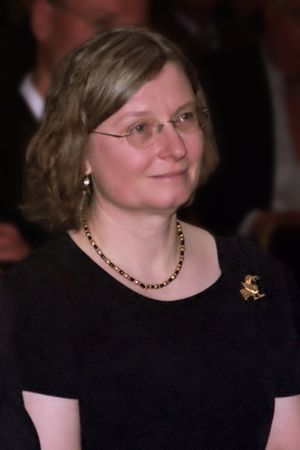Ingrid Daubechies
- Birthdate
- 1954/08/17
- Birthplace
- Houthalen, Belgium
- Fields of study
- Signal processing
- Awards
- 2011 John von Neumann Lecture Prize
1994 Steele Prize
1997 Ruth Lyttle Satter Prize
2019 L’Oréal-UNESCO For Women in Science award for North America
National Academy of Sciences Award in Mathematics
Jack S. Kilby Signal Processing Medal
Biography
Considered one of the best known female mathematicians, Ingrid Daubechies’ creation of practical wavelet transforms revolutionized signal processing and has impacted audio, image, and video devices and communications systems. Her development of orthogonal bases of compact support in 1998 was a watershed moment for the field of signal processing. Her work opened up new pathways of theory and applications for wavelets and filter banks and showed that their practical use in applications was indeed possible. Used for signal coding and data compression, the “Daubechies Wavelets” are now an indispensable tool for signal processors.
In her groundbreaking work, Dr. Daubechies demonstrated how to design well-behaved orthogonal wavelets using well-known filter banks and was able to provide a complete analysis. Dr. Daubechies then extended her wavelet techniques to expand their range of applications. In 1992, with A. Cohen and J.C. Feauveau, she developed a family of symmetrical biorthogonal wavelet bases to better handle image and video encoding problems. The eventual JPEG 2000 image coding standard, which enables applications such as next-generation entertainment systems and medical systems for telediagnosis, would be based on these wavelets and filter banks. Dr. Daubechies also worked with Wim Sweldens to apply Sweldens’ lifting algorithm to general wavelet transforms. The resulting algorithms offered state-of-art performance in speed and memory. She also applied lifting to a integer-to-integer wavelet transform that eliminated the noise present in standard transform coding algorithms. The lifted and integer-to-integer wavelets are key components of the JPEG 2000 standard.
Ingrid Daubechies was born on 17 August 1954 in Houthalen, Belgium. With encouragement from her school teachers and parents, and inspiration from learning about light refraction and prisms, she decided to pursue science. Ingrid Daubechies received her bachelor’s in Physics (1975) and Ph.D. in Theoretical Physics (1980) from the Free University in Brussels, Belgium. She was a Research Assistant (1975 to 1984) and Research Professor (1984 to 1987) at the Free University. This was until permanently moving to the U.S. in 1987 to marry mathematician Robert Calderbank and raise a family. She spent seven years as a member of the technical staff at AT&T Bell Laboratories. She also spent six months at the University of Michigan (1990) and Rutgers University (1991–1993). In 1994, she became a professor in the Mathematics Department and in the Program in Applied and Computational Mathematics at Princeton University. In 2011, she left Princeton for Duke University, becoming the James B. Duke Professor of Mathematics, serving as a professor in both the Department of Mathematics as well as the Department of Electrical and Computer Engineering.
As the President of the International Mathematical Union from 2011 to 2014, she helped expand access to math and science in developing countries. Daubechies became a member of the American Academy of Arts and Sciences (1993), was elected a member of the NAS (1998). In 1999, she became a Fellow of IEEE "for contributions to the theory of Wavelets."
